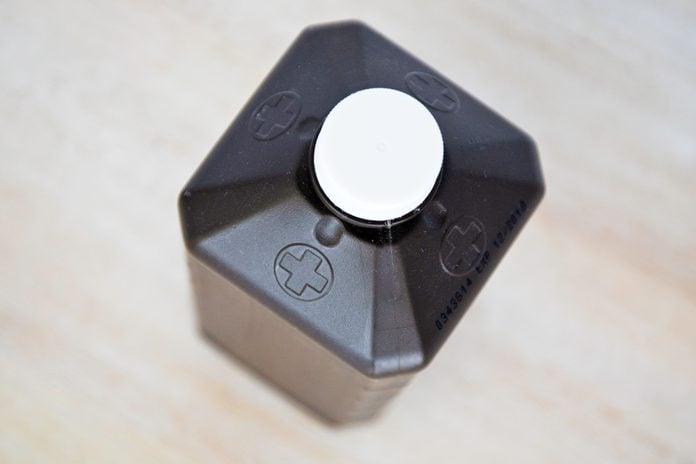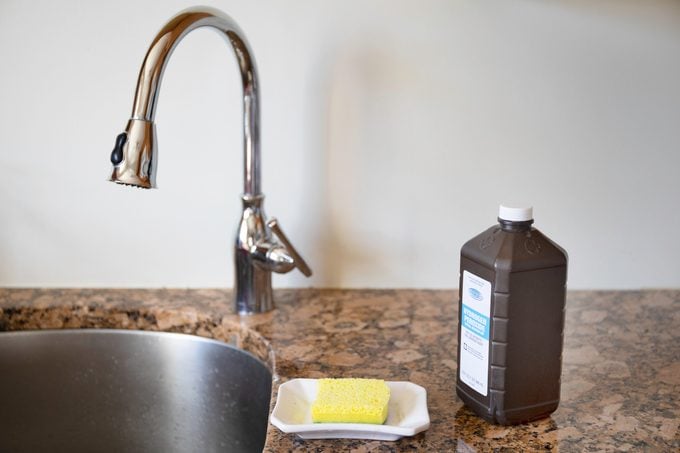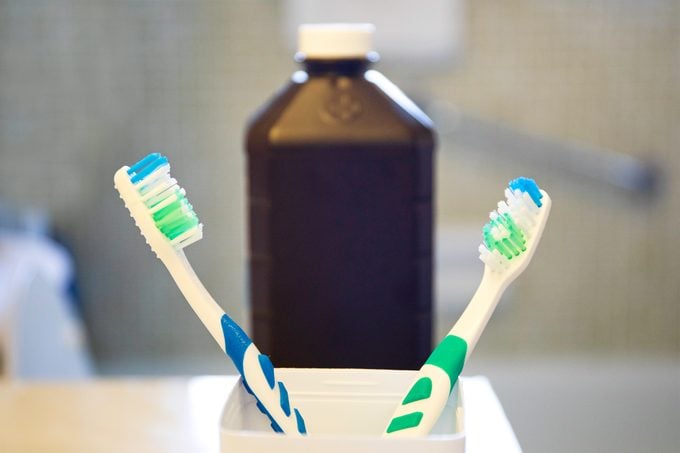25 Brilliant Uses for Hydrogen Peroxide You Probably Never Knew About
Updated: Apr. 05, 2023

Turns out, this medicine cabinet staple is the holy grail for your household needs.
Don’t you wish there was an all-in-one magic product you could use for anything? Yeah, we do too. There is something that’s pretty close to magic, though: hydrogen peroxide. Hydrogen peroxide is a common household item that’s safe to use for many purposes, like getting coffee stains out of carpet, getting rid of sweat stains, and removing chocolate stains. There are other key hydrogen peroxide uses that are total game-changers. Bookmark these 25 uses you probably never knew about—they’ll make your life SO much easier.
Remove stains of unknown origin
Can’t tell what that stain is, but still want to remove it? Try this sure-fire remover: Mix a teaspoon of 3% hydrogen peroxide with a little cream of tartar or a dab of non-gel toothpaste, rub the paste on the stain with a soft cloth, and rinse. The stain, whatever it was, should be gone.
Remove wine stains
One of the best hydrogen peroxide uses is removing wine stains. If you accidentally spill Merlot on your carpet, don’t panic. You can get it out quickly if you have hydrogen peroxide at home. Hydrogen peroxide is only one part of the cleaning equation, though—here’s how to get red wine out of carpet using other household items.
Remove grass stains
If grass stains are ruining your kids’ clothes, hydrogen peroxide may bring relief. Mix a bit of dish soap with a teaspoon of 3% hydrogen peroxide, let it soak, and then rub it out. As soon as it disappears, rinse with cold water and launder. Here’s more about how to remove grass stains.
Remove mildew
The sight and smell of mildew is a bathroom’s enemy. Bring out the tough ammunition: a bottle of 3% hydrogen peroxide. Don’t water it down; just attack directly by pouring the peroxide on the offending area and wipe it clean. The mildew will be gone before you know it. If you want more tips on how to battle this pesky home problem, here’s how to get mildew out of any surface.
Remove blood stains
This works only on fresh blood stains: Apply 3% hydrogen peroxide directly to the stain, rinse with fresh water, and launder as usual. We know blood stains can be a nightmare, especially if you’re out of hydrogen peroxide. Here’s how to remove blood stains with other common household items.
Sanitize your cutting board
Hydrogen peroxide is a surefire bacteria killer—just the ally you need to fight the proliferation of bacteria on your cutting board, especially after you cut chicken or other meat. To kill the germs on your cutting board, use a paper towel to wipe the board down with vinegar, then use another paper towel to wipe it with hydrogen peroxide. Ordinary 3% peroxide is perfectly fine to use.
Disinfect and brighten toilet bowls
Want to make your toilet bowl spotless? Melanie Musson, a cleaning expert with clearsurance.com, suggests pouring a half-cup of peroxide into the toilet and letting it sit for a couple hours. Then scrub the toilet bowl with a toilet brush. Grime and germs won’t stand a chance.
Disinfect kitchen sponges
Kitchen sponges remove a lot of gunk, which means they’re a breeding ground for germs and bacteria. One of the most convenient hydrogen peroxide uses is mixing it with water to disinfect sponges. Musson says mixing equal parts water and hydrogen peroxide and letting your sponges soak at the end of each day will do just the trick.
Sanitize countertops
Your countertops see a lot of traffic. Between prepping meals, unpacking groceries, and putting dishes away, many hands touch their surfaces—and lots of germs are transferred. If you don’t want to use a commercial cleaner to sanitize these high-traffic areas, Musson recommends mixing equal parts hydrogen peroxide and water in a spray bottle, spraying your countertops, and wiping them clean.
Clean the floors
Dirt, mud, pet hair…your floors have seen it all. Use a mixture of hydrogen peroxide and water to give them a thorough cleaning. Candice Batista, an environmental journalist and eco expert, recommends mixing equal parts hydrogen peroxide and water in a bucket and mopping your floors to make them shine. Be sure to do a patch test, though. Hydrogen peroxide can act like bleach, so make sure the mixture doesn’t damage your test area before you use it on your floors. Cleaning floors can be tricky—here are some things you should never use to clean your wood floors.
Sanitize and brighten grout lines
Sick of looking at grimy grout lines? Mix baking soda and hydrogen peroxide, grab a toothbrush, and start scrubbing. The paste will disinfect and brighten those tough spots between your tiles.
Disinfect cleaning supplies
That’s right—even your cleaning supplies need cleaning. Batista says one of the best hydrogen peroxide uses is to spray it on your cleaning rags, cloths, and sponges, let them bubble for five minutes, and then wash as usual. They’ll be fresh and ready to take on more messes. If you’re looking for safer cleaning supplies, here are some green house cleaning products professionals trust.
Plant care
Yep, hydrogen peroxide can make your plants healthier. Mary Ellen Ciganovich, a graduate student in environmental studies at UNC Asheville, says the extra oxygen in hydrogen peroxide can make plant roots healthier. The key is to dilute the hydrogen peroxide, so mix one teaspoon of 3% hydrogen peroxide per one cup of water when using it on plants. This trick can help you flex your green thumb! And even if you really don’t have one, here are 13 houseplants anyone can grow.
Sanitize toys
Kids love to play, but their toys can be a hot spot for viruses and bacteria. If you don’t want to clean them with a commercial cleaner, you can opt for a more natural mixture by using hydrogen peroxide and water. Nick Wilkesmann, a writer for cleaningking.com and owner of a small cleaning company, recommends mixing three parts hydrogen peroxide with 97 parts water to create a safe mixture that sanitizes toys. That way, you don’t have to worry about harsh chemicals lingering on your kids’ toys.
Disinfect mouth guards
Ever think about how much bacteria is on a mouth guard? Yuck. Wilkesmann also says you can use the mixture previously mentioned (three parts hydrogen peroxide with 97 parts water) to safely disinfect mouth guards. Bye bye, bad bacteria.
Sanitize your toothbrush
Your toothbrush helps rid your teeth and gums of germs and bacteria. However, they can stick to your toothbrush after a good brushing. To clean your toothbrush, place it in a small cup of 3% hydrogen peroxide (enough to submerge the bristles), let it sit for five minutes, and rinse thoroughly with hot water. We know there are other things you can clean with a toothbrush, so feel free to use this mixture to sanitize your cleaning toothbrushes, too.
Make a mouth rinse
There are many hydrogen peroxide uses for oral health. For instance, you could mix 3% hydrogen peroxide with water to create an effective and non-toxic mouthwash. It’s not recommended to use hydrogen peroxide that has a concentration higher than 3%, as it could damage your teeth.
Clean your makeup brushes
Makeup brushes are great tools, but they’re also a breeding ground for germs and bacteria. We don’t want any of that getting on your face. Batista recommends mixing one part water with one part hydrogen peroxide, soaking your brushes for five minutes, and letting them air dry. They’ll be sanitized and ready to use in no time! Here are more tips on how to clean makeup brushes quickly.
Clean your mirrors
If you want a natural cleaner that will leave your mirror streak-free, look no further than hydrogen peroxide. Simply put 3% hydrogen peroxide in a bottle, spray the mirror, and wipe. This simple solution will make your mirrors shine!
Sanitize nail clippers
When was the last time you sanitized your nail clippers? We won’t judge if it’s been a while (or never). It’s important to sanitize your nail clippers, especially since harmful bacteria and fungus could linger on their surface. Luckily, there are hydrogen peroxide uses that will help you sanitize this commonly used personal care tool. Simply pour hydrogen peroxide into a container, submerge the nail clippers for three to five minutes, and dry with a paper towel.
Sanitize a litter box
You love your cat, but you likely don’t love their litter box. Luckily, you can use hydrogen peroxide to sanitize it and help get rid of the odor. You can put 3% hydrogen peroxide into a bottle and spray the sides, then pour some hydrogen peroxide into the bottom of the box. Let the litter box sit for 30 minutes, dump the remnants down the drain, and wash the litter box with warm water. Goodbye, smelly litter box.
Clean an aquarium
Aquariums can get pretty dirty if they aren’t cleaned regularly. If you want to give your aquarium a deep clean, you can use hydrogen peroxide to get the job done. Mark Valderrama, owner and founder of the Aquarium Store Depot, says it can be a game-changer for a dirty tank. “I know that hydrogen peroxide is safe to use in killing algae in your aquariums, ” says Valderrama. “Hydrogen peroxide is safe to mix with tank water and won’t do any harm to your pet fish as long as you follow the proper dosage.” He does note that using hydrogen peroxide to do a deep clean should be a last resort and that tanks should be cleaned regularly to avoid algae buildup.
Wash produce
One of the most handy hydrogen peroxide uses is to use it to wash produce. Washing your fruits and vegetables with a mixture of warm water and food-grade hydrogen peroxide can help remove bacteria. Make sure you rinse the produce thoroughly before eating it.
Brighten your whites
Want to brighten your white clothing but don’t want to use bleach? Grab the hydrogen peroxide. Batista says she uses it to brighten up her laundry. “Use 3-6% and simply add a cup to your regular wash cycle instead of bleach,” says Batista. Make sure you don’t mix hydrogen peroxide with bleach. Here are more cleaning products you should never mix.
Sanitize the garbage can
Let’s be real: Our garbage cans stink. The smell doesn’t have to linger, though. You can use hydrogen peroxide to sanitize the can and get rid of foul odors. Pour 3% hydrogen peroxide in the bottom of the can, let it sit overnight, pour water into the can the next day, swish it around, and dump the excess mixture. You can also spray hydrogen peroxide along the inside of the can and rinse it out to get a deeper clean. Your nose will thank you later.
Things you should not use hydrogen peroxide for
- Cleaning colored fabrics—it will bleach the color
- Cleaning deep cuts—it can be used sparingly on small cuts and scrapes, but it can kill healthy bacteria and slow the healing process for deep cuts
- Cleaning metal items, such as food and water dishes for your pet or cages—there’s a chance it could make metal rust faster
Important things to remember when using hydrogen peroxide
- Wear protective gloves when using hydrogen peroxide—while it is a natural substance, it can still burn your skin
- Do not mix hydrogen peroxide with vinegar, ammonia, or bleach—the combination could produce dangerous fumes
- Keep hydrogen peroxide out of the reach of children
Next, find out the cleaning products you’ve been using the wrong way.
Sources:
- Melanie Musson, cleaning expert with clearsurance.com
- Candice Batista, Editor-in-Chief and founder of The Eco Hub
- Mary Ellen Ciganovich, graduate student in environmental studies at UNC Asheville
- usinghydrogenperoxide.com
- Nick Wilkesmann, writer, cleaning-king.com
- Mark Valderrama, owner of Aquarium Store Depot
- Marshfield Clinic Health System

